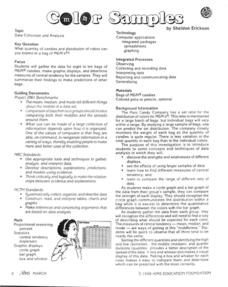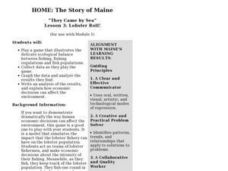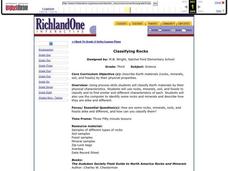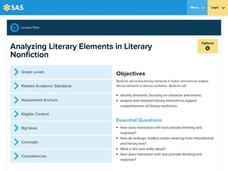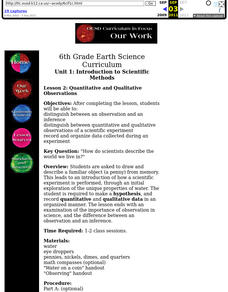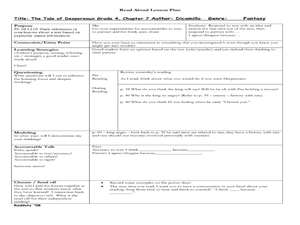Curated OER
Whose Clues?
Students investigate interrelationships between animals and their environment by observing clues to wildlife activities, and inferring about the types of wildlife present in an area and their activities.
Curated OER
Colors Samples
In this math worksheet, students take the time to count out the colors of the candies. They graph the results and make inferences from the information.
Curated OER
Making Sounds
Students perform three experiments to gain understanding of how pitch changes. In this sound lesson, students create a variety of sounds with different pitches. Students will record their data as the observe the differences in the sounds...
Curated OER
QuickPlan: Mystery Boxes
Primaries explore the concepts of observation and inference. Given a set of six sealed boxes, children lift, tip, or gently shake in order to make observations about what is inside. The lesson plan gives preparation instructions in...
Curated OER
Maniac Magee: Questions to Foster Discussion
This resource provides 11 short answer questions and a couple of extension ideas related to part one of Jerry Spinelli's novel about a feisty runaway. Not reproducible, but the questions (which address vocabulary, inference, recall,...
Curated OER
Japanese Objects as Cultural Artifacts: A Model Lesson Using Textiles
Middle schoolers complete a unit on the cultural significance of textiles in the Japanese culturre. They analyze cotton, line, silk, and wool fabrics, examine various fabric creation and decoration techniques, select an object and write...
Curated OER
Lesson Plan on Important Citizens in the American Civil War
Students, in groups, half representing the Confederacy, half the Union, conduct research to find out about important Civil War era citizens from each side. They explore the effect these people had on the war and what effect the war had...
Curated OER
Lesson Plan on Military Leaders in the American Civil War
Young scholars, in groups, half representing the Confederacy, half the Union, conduct research to find out about important Civil War military leaders from each side. They find the answers to a variety of questions regarding their...
Curated OER
Electricity - Lesson Plan
Tenth graders should explain some basic properties of electricity and know how electricity is produced. They should also explain the electrical components that make up electric circuits.
Curated OER
Sound - Lesson Plan
Tenth graders should know how sound is produced and state some properties of sound.
Curated OER
IT - Lesson Plan
Tenth graders should appreciate the importance of Information Technology in our daily life.
Curated OER
Lesson 3: Lobster Roll!
Students play a game that illustrates the delicate ecological balance between fishing, fishing regulations and fish populations. They collect data and analyze the results.
Curated OER
Classifying Rocks
Third graders classify rocks. In this rocks and minerals lesson, 3rd graders observe, make inferences and conclusions about rocks, minerals, soil and fossils.
Curated OER
Location, Location, Location: Using a Grid to Determine Context
Seventh graders are introduced to making inferences about artifacts. Using a grid system, they locate the artifacts and determine where they originated from. They use this information to make conclusions about the way people lived...
Curated OER
Civil War Music - Irish Folk Songs
Students determine what it was like to serve as an Irish-American in the American Civil War. In this Irish folk song lesson, students use the provided worksheets to analyze selected Irish folk songs and make inferences about war...
Curated OER
Do You Have a Sinking Feeling?
Young scholars explore how marine archaeologists use data to draw inferences about shipwrecks. In this marine archeology lesson students plot the position of a vessel, draw inferences about a shipwreck and explain the possible...
Curated OER
Classification of Animals
Students explore animal characteristics by participating in a SMART board activity. In this animal classification lesson, students utilize a sorting chart to divide different animal names by their observable characteristics. Students...
Pennsylvania Department of Education
Analyzing Literary Elements in Literary Nonfiction
Fourth graders identify the literary elements of a nonfiction text. In this literary elements lesson, 4th graders read the text Piano Starts Here--The Young Art Tatum and fill in a chart that includes the events from the book....
Curated OER
The Aging Population of Canada
Students analyze age-group population data and make inferences on the impact of the aging population in Canada. They, in groups, focus on health care, social programs and labor issues.
Curated OER
Introduction to Scientific Methods
Sixth graders distinguish between an observation and an inference distinguish between quantitative and qualitative observations of a scientific experiment. They record and organize data collected during an experiment.
Curated OER
The Tale of Despereauz
Fourth graders read text and draw inferences or conclusions about the text. In this reading lesson, 4th graders discuss their opinions on what was read and state why they think that way to a partner.
Curated OER
Apply Post-Reading Skills and Discuss Persuasive Text
Students put their reading comprehension skills to practice. In this interpreting text instructional activity, students read "Chief Red Jacket's Reply," and then respond to questions that require them to reason, infer, and analyze the...
Curated OER
Biochemistry Detectives
High schoolers explore the process of chemosynthesis and relate it to the biological communities in cold seeps. In this biochemistry instructional activity students interpret analyses of enzyme activity and draw inferences about...
Curated OER
Potential and Kinetic Energy
Sixth graders explore potential and kinetic energy. In this science lesson plan, 6th graders assume the role of a roller coaster engineer and design a roller coaster. Students use their knowledge of kinetic and potential energy to design...



